This week, two things reminded me of something that I have been meaning write about for The Votives Project for a while. The first was the excellent Remarkable Things conference at the University of Warwick (10th March 2018), where several papers drew attention to different types of (broadly conceived) apotropaic object. This included, for the ancient Greek and Roman worlds, presentations on Aegyptiaca in early Greek burials and sanctuaries, images and texts concerning the evil eye, and dust tokens invested with divine power. The second prompt was a report (with excellent photos) on the discovery of 5 small lead mirror frames from a site in Bulgaria. The recovery of these items appears to be compelling the excavators to rethink their interpretation of the largely ‘residential’ structures they were associated with, perhaps suggesting that instead these served a religious purpose (although in my opinion the two possibilities are not necessarily mutually exclusive). As a consequence, I was reminded of the small lead item that currently resides on a bookshelf in my study.


Several years ago – none of us involved can quite remember when, but probably around 2002 or 2003 – some non-archaeologist friends of mine presented me with a ‘strange lead thing’ that they had found whilst out walking in Yorkshire (unfortunately they can’t now remember where). At the time I had no idea what it was – a circular piece of lead, with a hole in the middle, about 4 cm in diameter, with some small triple-knopped projections at the base suggesting that something once projected from it, one surface left unworked except for some concentric circles (likely from a mould) and the other decorated with closely set oblique lines and tiny round protrusions (4.1 x 4.2 cm; hole: 1.9 x 1.3 cm). Assuming it was 18th or 19th century, and perhaps linked with agricultural activities, it languished for years in my box of ‘assorted interesting things I’ve collected’ until in late 2016 a Google alert for ‘votive’ quite literally alerted me to a sale of some items that looked almost exactly like my mystery lead artefact (at the time of writing, a similar lot can be seen here, and a quick Google Image search reveals more). The items on sale showed small thin handles projecting from similarly decorated circular pieces of lead, with angular holes in the centre. I soon learned that the hole is believed to have once held a small piece of glass (or perhaps a semi-precious stone or other reflective material?) that served as a reflective surface. They were labelled as ‘ancient Roman lead decorated votive mirrors’.
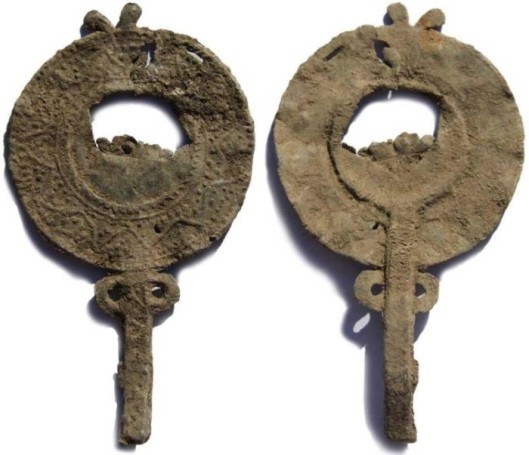
“Ancient Roman Votive Lead Mirror 2-4th Century AD”, on sale at https://www.vcoins.com/en/stores/cerberus_ancient_coins/31/product/ancient_roman_votive_lead_mirror_24th_century_ad/76789/Default.aspx
Doing some digging around over the last year or so, I’ve found that remarkably little has been written about this type of object. I consulted Philip Kiernan, of Kennesaw State University, whose book Miniature Votive Offerings in the North-West Provinces of the Roman Empire (2009) is the go-to item for things like this, but it appears that most of the known examples fall outside the geographical limits of his study area, coming from the Roman provinces of the central Danube region (e.g. Pannonia, Dacia, Moesia). He pointed me towards some examples, dated largely to the 2nd-3rd century CE, currently in the Hungarian National Museum in Budapest (Németh and Szabó 2010) and in Varna Archaeological Museum, Bulgaria (Kouzov 2002). These confirm that my mystery item is indeed a miniature mirror, although quite what it was doing so far west, in Britannia, remains unknown.
The object itself has got me thinking once again about how we decide what is or is not a votive offering, including the complex relationship between ‘magic’ and ‘religion’, as well as the role that material objects themselves played in ritual activities. In this case, it appears that the label ‘votive mirror’ rests on three rather fuzzy factors. Firstly, their form and the fact that they are miniature. By making an everyday item too small to perform its customary function it can be transformed into something ‘deliberately dysfunctional’ (Foxhall 2015, p. 2), which in turn is often interpreted as indicating a ‘ritual’ function for an object that ‘ghosts’ its prototype. As Lin Foxhall (2015, p. 3) continues: ‘the change in scale may serve to make the ordinary extraordinary, signalling a change in the sociality of an object which mirrors its change in relation to the body. Hence, a miniature … allows the users to think the unthinkable.’ Certainly, these mirrors could serve only a very limited practical purpose within personal care, because at only around 2 cm diameter their glass surface was simply too small to reflect the beholder in any detail. György Németh and Ádám Szabó (2010, p. 101-102) also dismiss their use in everyday beauty activities for this reason and because of the softness of the lead, which is not suitable for ‘everyday utensils’, noting also that ‘The mirror frames were made of lead not only because it was cheap and easy to shape (mirror frames were moulded in matrix), but also because the colour and the weight of lead traditionally associated it with the underworld and with magic.’ Lead was commonly used for curse tablets in the Latin west, but these are usually considered ‘magical’ rather than votive, so there is possibly some more thinking to be done here about choice of material, and whether lead must always = ‘magical’, and by extension whether that also = ‘votive’.
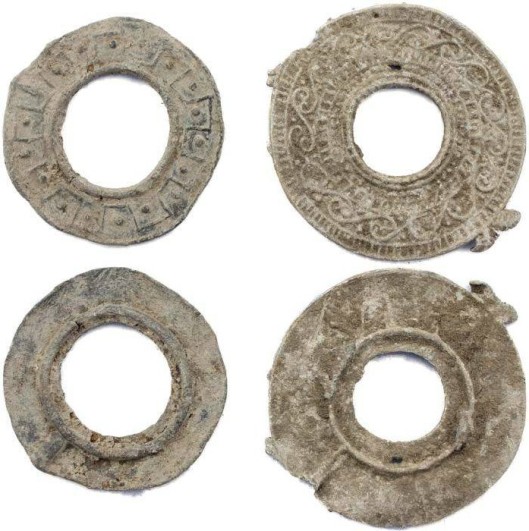
“Ancient Roman Votive Lead Mirror 2-4th Century AD”, on sale at https://www.vcoins.com/en/stores/cerberus_ancient_coins/31/product/two_ancient_roman_votive_lead_mirrors_24th_century_ad/77063/Default.aspx
Secondly, several miniature mirrors from the central Danube region are inscribed with Greek and Latin phrases which, as Adam Parker (OU PhD student and Assistant Curator of Archaeology at York Museums Trust) notes, also point towards their use in ritual, magical or other apotropaic contexts: Utere Felix (‘Good luck to the user’ or ‘Use with luck’), ‘To a beautiful soul’ and ‘successfully’, the latter perhaps indicating a successful vow? It is not always clear whose soul is considered beautiful: that of a mortal woman owner, or a deity to which the item is dedicated. One example from Bulgaria appears to make explicit reference to votive-like activities: ‘[I] am the thank-offering’ (Kouzov 2002, p. 63), although to whom and for what it is not clear. Again it is difficult to untangle a truly votive function from one of more general good fortune, or to distinguish easily between practices that were (in modern terminology) primarily religious or magical in nature.
Finally, there are the contexts in which they may have been used. Giulia Baratta (2009) notes that many are unprovenanced, but reports finds from votive deposits (stipes) in sacred areas in southern Gaul, as well as inscribed dedications made to Selene, Aphrodite, Venus, Isis, Hera and the Nymphs. On the other hand, Németh and Szabó (2010) report that many examples from the Danube region were found in the graves of women, where they perhaps served as grave goods considered appropriate for their connection with general issues of fertility, good fortune, and beauty, or even as protective amulets. One newly discovered example from the villa site at Pavlikeni in Bulgaria appears, from one of the photos, to have been folded perfectly in half, comparable to the treatment of some lead curse tablets that are folded, rolled, or pierced (McKie 2016). It is tempting to see this as some sort of ritual ‘killing’ of the object, a way of putting it out of use or transforming its function, for it would have entailed the breaking or removal of the reflecting glass, perhaps in the way that the surfaces of some Etruscan mirrors were mutilated before they were placed in tombs (De Grummond 2008). However, until the Pavlikeni site is published, the circumstances surrounding whether this folding was pre- or post-depositional remain unknown. Once again, though, the function of the mirrors seems difficult to determine. Were they actively used in ritual activities before being kept and only much later placed in graves? Were they items that a young woman owned and gave up to the gods at a particular moment in her life, with those who died before that moment taking them to the grave instead? Or were they small-scale replicas of items used in daily life that were produced specifically to be offered to the divine, either those of the underworld or those of a local sanctuary? I suspect there is no single answer, in fact I wonder if really we shouldn’t be asking different questions.
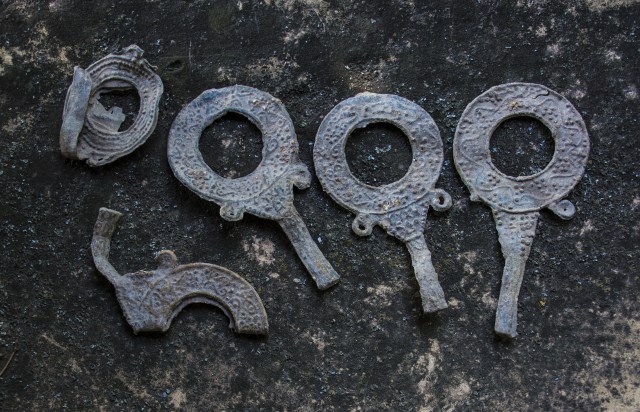
Five lead frames from a 2nd-3rd century CE building near Bulgaria’s Pavlikeni. Photo: Archaeologist Kalin Chakarov (http://archaeologyinbulgaria.com/2018/03/10/archaeologist-discovers-ancient-mirrors-roman-villa-estate-ceramics-factory-bulgarias-pavlikeni/)
These lead mirrors may have been small, but people still manipulated them as part of some form of religious or magical activity. What happens if we ask questions about the experiences that this entailed? For example, might their small size have been important not just for creating a sense of control over the everyday world that comes with grasping a miniaturised object, but also over the (perhaps not-everyday) image reflected in the glass? After all, in the words of Doug Bailey (2014, p. 29), ‘in relation to what is represented in small-scale, one is made to feel larger in size and advanced in hierarchical position; a soothing sense of wellbeing follows.’
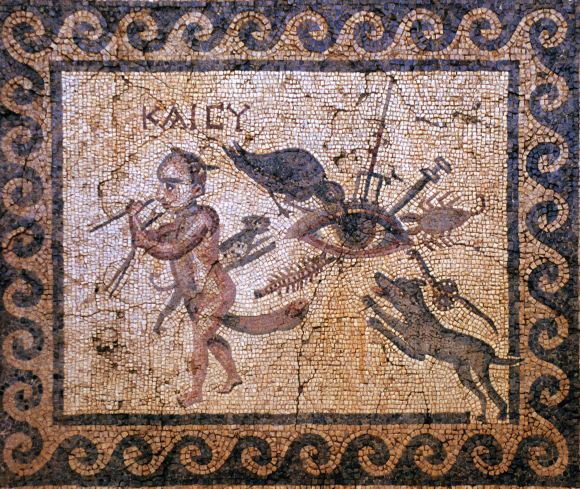
Roman-era mosaic from Antioch depicting a plethora of devices against the evil eye (Wikimedia Commons: Public Domain)
There are also interesting questions here about viewing and being viewed as part of ritual practices. Inscriptions appear on both the front and back so who was supposed to read them? How reflective were they and who were they intended to reflect? The human user, the divine, someone or something behind the user? At the Remarkable Things conference, a presentation by Irene Salvo (University of Göttingen) on the ancient evil eye, reminded me that as an action, apotropaism might be both passive and deflective, as well as active and aggressive. Could there be a link to evil eye here too? The glass itself was not a dissimilar size to a human eye and might well be used to reflect the users own eye, or that of another, or even to protect against the evil eye cast by someone else, directly deflecting the curse back towards them. It might even be used to look behind oneself without risking too much exposure. Could they have offered a way of protecting against malevolent forces when entering an uncertain space, like that associated with death but also with some sanctuaries or mystery rites? Was it then left behind as a thank-offering? This is a good reminder that we know so frustratingly little about how ancient people approached the divine with their offerings. And of course, miniature mirrors were also limited in terms of what they could reflect, the glass likely offered the viewer a rather unclear image, potentially blurring the edges of their body, at the same time revealing their body to them in small fragments: something that might be entirely appropriate for a votive setting in which bodies were customarily fragmented (Hughes 2008).
If they were actively used in sanctuaries or other ritual activities, and not only as grave goods, we should perhaps also think carefully about assigning them to one gender. It is true that some have been found in female graves, but the provenance of most remains unknown, and this also doesn’t necessarily mean that women were the only ones who used them in non-funerary contexts. The general tendency to assume that mirrors were female items makes me uncomfortable: surely men used them too (for personal grooming or for the ritual purposes I’ve speculated about here), even if they were not so regularly buried with them.
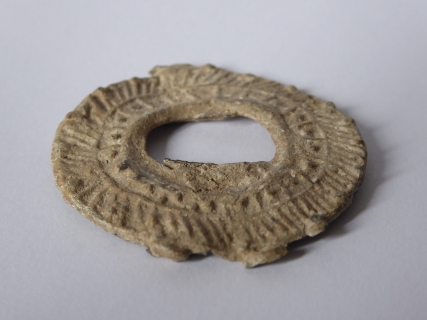
No longer just a ‘strange lead thing’ but a Roman imperial period miniature lead mirror frame, from somewhere in Yorkshire, UK.
Although I now know what my ‘strange lead thing’ is, it has prompted as many questions as I’ve been able to find answers, and I suspect that there is a lot more to say about these objects than I’ve managed in this short, rather speculative, piece. It is also quite concerning that so many appear to be available to buy online, where they are devoid of context and destined to move further out of the reach of archaeological study. If anyone knows of any more examples of miniature lead mirrors, especially from secure contexts, please do let me know!
E-J Graham
Many thanks to Adam Parker and Phil Kiernan for discussing these items with me and helping me chase some relevant bibliography. And, of course, huge thanks to eagle-eyed Claire Richardson and Sally Kirkham for spotting such an unprepossessing piece of lead in the first place.
References
Bailey, D. (2014) Touch and the cheirotic apprehension of prehistoric figurines, in P. Dent (ed.) Sculpture and Touch, Ashgate, pp. 27-43.
Baratta, G. (2009) La bella e lo specchio: alcune iscrizioni greche su specchietti in piombo, in A. Martinez Fernandez (ed.) Estudios de Epigrafia Griega, La Laguna, pp. 427-454
De Grummond, N.T (2008) On mutilated mirrors, in M. Gleba and H. Becker (eds) Votives, Places and Rituals in Etruscan Religion, Brill, pp. 171-182.
Foxhall, L. (2015) Introduction: miniaturization, World Archaeology 47(1,), pp. 1-5.
Hughes, J. (2008) Fragmentation as metaphor in the Classical healing sanctuary, Social History of Medicine 21(2), pp. 217-36.
Kiernan, P. (2009) Miniature Votive Offerings in the North-West Provinces of the Roman Empire, Verlag Franz Philipp Rutzen.
Kouzov, C. (2002) Lead Roman mirrors in Varna Archaeological Museum, Archaeologia Bulgarica 6(3), pp. 63-99.
McKie, S. (2016) Distraught, drained, devoured, or damned?: The importance of individual creativity in Roman cursing, in M. Mandich et al. (eds) TRAC 2015: Proceedings of the 25th Annual Theoretical Roman Archaeology Conference 2015, Oxbow, pp. 15-27.
Németh, G. and Szabó, A. (2010) To a beautiful soul: inscriptions on lead mirrors, Acta Classica Universitatis Scientiarum Debreceniensis 46, pp. 101-113.



Pingback: Etruscan Votives (an audio interview with Professor Jean MacIntosh Turfa) | The Votives Project
I’ve one of those mirrors in my collection with the central object still intact. It’s absolutely not a mirror but some kind of translucid crystal.